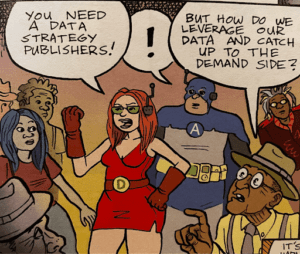 Last summer, analysts and industry players predicted viewability would become the standard metric for display branding performance. But for Jonah Goodhart, CEO of analytics services provider Moat, viewability is a starting point to determine the value of a display placement instead of the tool that will kill the clickthrough.
Last summer, analysts and industry players predicted viewability would become the standard metric for display branding performance. But for Jonah Goodhart, CEO of analytics services provider Moat, viewability is a starting point to determine the value of a display placement instead of the tool that will kill the clickthrough.
“Two-thirds of all the world’s ad spending is on branding, but in digital, only a quarter is devoted to promoting awareness and affinity,” Goodhart said. “One of the reasons is that there are no consistent standards of success for brands.”
The Web is more of a direct response medium as opposed to branding one. For a CPG business like Procter & Gamble or a soft drink company like Coca-Cola, there’s no way to truly measure online ad success, Goodhart said. Yet ecommerce sites like Gilt Groupe or a web-based businesses like Netflix clearly see if their ads work: Prospects are driven through a landing page process, the sites drop a pixel, and the companies see how many people converted.
“People don’t buy Coke on a website, we don’t buy individual grocery brands online,” Goodhart said. “The brands with the most ad spending in the world have the biggest challenge when it comes to figuring out ROI.”
Numerous ad tech players have ramped up their viewability offerings this past year, as the Media Ratings Council gave their accreditation to measurement tools from Google, DoubleVerify, RealVu, Spider.io, among several others. While the advertising industry generally agrees on the basic idea of viewability –that an ad was actually served in a viewable position – there still isn’t an industrywide standard and there’s still controversy around assessing what happened after the ad is seen, Goodhart said.
“If we don’t have a clear, agreed-upon measurement, we default to the click as being that signal,” Goodhart said. “The click is a bad signal for a lot of reasons, the obvious one being that nobody does it. Solving this problem is a huge opportunity.”
The online advertising industry’s biggest mistake in developing a solid metric, Goodhart said, was its wrongheaded attempt to equate two fundamentally different mediums: the Web and TV.
For example, TV commercials interrupt the content on the screen completely. So measuring viewers according to broad age ranges, gender and demographics makes sense. The spending is great, but the likelihood of an ad being seen and having an impact can result in corresponding ROI.
The same cannot be said for online.While there’s more opportunity to serve ads to numerous sites with niche audiences, online banner ads aren’t more impactful than TV spots.
“With digital, it’s as if you’re driving down the highway and you pass a billboard that’s actually flipped the other way,” Goodhart said. “To put it another way: it’s as if when you’re watching a TV program on the left side of the screen, there are nine commercials playing simultaneously on the right side, while the advertiser asks if they reached the right audience. Viewability is a piece of solving that. How can someone pay attention if the ad wasn’t there to begin with? But that doesn’t mean the consumer actually paid attention.”
Moat’s tools are designed to let brands know if a consumer stopped and paid attention to their ad and for how long. Heatmaps in Moat’s system can also show where on a display, video or native ad (either on PC or mobile) a users’ cursor hovered and for how long. That allows clients to compare how different ads performed from an engagement standpoint.
“The real question we’re thinking about as the technical hurdles are past is: How does the market change once viewability becomes the metric buyers and sellers start transacting on?” Goodhart said. “That’s where it gets really interesting.”
Moat primarily works directly with publishers and charges a monthly fee for its services, instead of relying on a CPM-based “volume” model. The company has 40 staffers currently, 25 of whom are in engineering. Thanks in part to proceeds left over from this past spring’s $13 million second round funding, the plan is to hire more staffers on the engineering as well as marketing sides, Goodhart said.
In addition to entering 2014 with a good deal of cash on hand, the three-year-old company expects fewer external distractions. In November, a Virginia court dismissed a patent violation claim brought against Moat by comScore. The suit, initiated July 2012 against DoubleVerify, AdSafe (now known as Integral Ad Science) and Moat, charged the trio used at least four of the same patents comScore acquired rights to when it was sued by, and settled with, measurement rival Nielsen the year prior (Confused? See the original suit here or just read the settlement press release here).
While Integral and DoubleVerify settled last spring, Moat fought on. Goodhart would not comment on the suit, beyond referring to a released statement that said the legal matter was “dismissed with prejudice. No money changed hands and no licenses were granted.”










